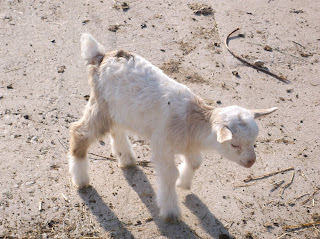There can be a lot of confusion over what is considered what, and I hope this helps. All goats used here are fainters as represented by their respective owners.
Black: Pure black is just that, pure black. They may have a frosted muzzle and ears, or not. Should be nice and shiny.
White: Pure white without any other markings.
Above pictures from Harley's Barn.
Above picture from West Wind Acres.
Black and white: By far the most common color pattern in fainters. They can be black with a lot of white, black with a little white, and some very interesting patterns like Phoebe (the one take the bow) who has ticking in her white.
Above picture from Harley's Barn.
Brown (chocolate), brown and white: Brown is often called chocolate, but it's the same coloring. Brown and white is simply brown with white markings. Any other color along with the brown and white would make it a tri-color.
Tri-color: Tri-color is just that, any combo of three colors. There are quad colored goats (usually, but not always moon spotted).
The two does above are a very different tri-color.
This doe above is considered the black/tan tri-color pattern.
This girl has black on her legs making her a flashy tri-color.
Tan/apricot: Paler then brown, but not white.
Picture above from West Wind Acres.
Blues: Blue is grey coloring. Often has white on them as well.
Reds: Reds are, well, red! They are not brown, nor tri-color (although some reds do have black markings). They should be a deep red, or a rusty red.
Roans: Roans are any solid color mixed with white.
Above, purple roan with red cheek pattern.
Above, bay roan pattern.
Above, red roan pattern.
Moon spots: Moon spots are any color spot other then black or white, on a solid base. So a white goat with black spots is not moon spotted, and nether is a black goat with white spots. But a black goat with tan or brown spots is, and a white goat with brown patches and grey spots ON the brown patches is also moon spotted. Also, in order for the spots to be passed on, one or both parents must have a moon spot. Moon spots are a dominant gene. Moon spots can not randomly pop up in a goat. But sometimes they can be hidden on the coat and hard to see. They can be just a few hairs, and can be hidden under white (white is not an actual color but lack of color). Or they can be so close to the main color it's missed. While some goats throw the spots on their kids easily, others rarely seem to despite lots of them. On kids, the moon spots can be very dark and lighten up considerably as they mature.
Above from West Wind Acres.
Above from The Bar T Ranch.
Badger face/blackbelly: These have bands of black on their stomach, legs, dorsal, and around their face.
Above pictures from The Bar T Ranch.
Flowery: These have "feathering" on the solid coloring on their bodies. They are generally black, brown/tan, and blue.
Buck above is sire to this buckling.
Peacock pattern: Called Cou Claire or Cou Blanc in dairy goats, the peacock pattern is always lighter on the head and neck, and darker on back of body. Peacock patterns with white are called "broken" peacock.
Above, even though she has a lot of white, if you look closely at her facial markings, you can see the peacock patterning.
Red Cheek: The red cheek is just that, red cheeks on the goat.
This is the same doe, just showing both sides.
Goulet pattern: The goulet pattern is considered white head, solid eye patches or white around eyes, then solid body color with white in it.
Above, this doe is not "quite" Goulet but very close.
Above, this doe shows the other colors that Goulet can come in, while she isn't "quite" Goulet either, again, very close.
Above, this buck shows the Goulet pattern with the white head, darker around eyes, then solid body and white mixed in. All three photos come from Liberty Hills Farm.
Keep in mind, there is a lot of different colors out there. This is simply a guide to help people understand the different colors. I personally will not buy fainting goats with pygmy or Nigerian colors as they do not naturally occur in the fainting goat. Remember, Mini Silky goats are fainters who are often crossed with Nigerians (per their breed standard) and so double check to ensure you are indeed getting a purebred fainter if that is what you are looking for!
A big THANKS! to all the breeders who allowed me to use their photos!















































No comments:
Post a Comment
Note: Only a member of this blog may post a comment.